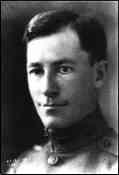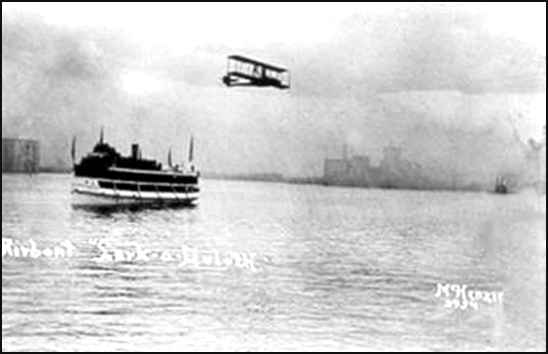

Roger Jannus is on the port side with raised goggles, 1916
Washington University Archives.
Thomas Reilly Collection.
 |
 |
||
| Tom Benoist's G-17 boat at Sandusky, Ohio in 1916 Roger Jannus is on the port side with raised goggles, 1916 Washington University Archives. |
Roger Jannus, 1917 Thomas Reilly Collection. |
|
by Thomas Reilly ROGER WEIGHTMAN JANNUS seemed forever to be in the shadow of his younger brother, Tony. Tony Jannus was one of America's pioneering airmen from 1910 through 1916. He earned fame for his record-breaking 1,973-mile flight from Omaha, Nebraska, to New Orleans in 1912, and for being part of the first drop of a parachutist from an airplane. In 1914, he was one of the driving forces behind the organization and the success of the St. Petersburg-Tampa Airboat Line, recognized as the world's first scheduled passenger airline. The premature death of Tony in 1916 at the age of 27 served to strengthen his legend. But there was another Jannus, and that was Roger Weightman Jannus, the son of Frankland and Emeline Carlisle Weightman, who was born in Washington, D.C., on December 25, 1886. Following his graduation from high school, Roger studied engineering. He earned a degree in civil engineering from Lehigh University, eventually ending up in Panama as an engineer on the Panama Canal |
|
"UP IN THE AIR WITH JANNUS" AVIATION GIVES ALL THE WORLD'S THRILLS COMBINED |
 |
|
|
about the thickest air one ever tried to breathe. There seemed to be a super-abundance and all wanting to get into one's lungs
at once. A peep over the side and below us lay a great ore boat. Jannus played an awful joke on that boat. . |
Aviator Jannus |
|
Matches Give the Lover of Sport a Varied Choice. The Duluth News Tribune Duluth, MI, July 3, 1914 Collection of Alvin Grady, 10-3-06 At Desmond park the lodge teams will clash with great gusto--real doings. A race around the Point beween Jannus in his flying boat and W. D. Jones in his speedy motorboat will be a big feature. |
|
At the end of 1914, Roger, Tony, J.D. Smith and Knox Martin, new to the company, decided to take the Benoist flying boat Number 43 to San Diego, California. By early January, Roger, Smith and Martin were in California. Tony had remained in Baltimore. The California contingent did a thriving business. While at San Diego, Roger received seaplane pilot's license Number 26 from the Aero Club of America. J.D. Smith crashed the flying boat into San Diego Bay on February 19. It was not salvageable. Jannus and Smith headed back east. While Roger was in California, Tony's test flying of the Jannus Flying boat had gone well. The brothers signed a contract to operate at a Toledo beach resort, located on Lake Erie, during the summer. At the same time, W.E. Davidson of Detroit bought the Jannus flying boat. While Tony was in Detroit supervising the assembly of the aircraft, he made a side trip to Toronto. There he met with J.A.D. McCurdy, general manager of Glenn Curtiss's Canadian aircraft operation. When Tony decided to go to work for Curtiss, Roger fulfilled the remainder of the summer contract at Toledo. Roger spent the next several months flying for other people, including Tom Benoist. While in Sandusky, Ohio, he test flew Benoist's Model G-17 boat, two-engine, seven-passenger flying boat. In April 1916, Roger went to work for the Curtiss Aeroplane Company and went to Russia where he engaged in diplomatic work for Curtiss. In August, after only four months in Russia, Roger returned to America. Two months later, Tony crashed a Curtiss H-7 flying boat into the Russian Black Sea and was killed. Several early American aviators have given Roger Jannus credit for devising a maneuver that would correct a deadly tailspin. Arthur L Richmond, a young Harvard-educated student assigned to Jannus's class at Miami, recalled that "Roger Jannus was the first pilot, to my knowledge, to have had the temerity to push the controls forward and use the rudder against the direction of the spin, thereby putting the airplane in a vertical position earthward, but regaining flight speed which brought back sufficient pressure on the elevator controls to pull the ship out of the dive after flying speed had been regained." During the spring of 1918, Captain Jannus was assigned to the Overseas Training Liason Mission, a command of pilots highly trained in aerial pursuit and bombardment. By mid-July, Roger had arrived in France and attended bombardment school at Clermont-Ferrand, near Vichy. He then received orders to the pursuit school at Issoudon, Jannus flew the British-designed de Havilland-4, a single-engine two-seat reconnaissance bomber. The DH-4 had been nicknamed the "Flying Coffin" and was described as two wings on a hearse, all for good reason. It was a dangerous aircraft to fly. His death did not go unnoticed. General John J. Pershing, commander-in-chief of the U.S. Army's American Expeditionary Force, cited Roger for "Bravely laying down his life for the cause of his country." President Woodrow Wilson wrote that Jannus "served with honor." France's president posthumously awarded Roger Jannus the Pendant la Grande Guerre. Roger Weightman Jannus's aviation accomplishments were many. An Early Bird flier, he was the recipient of one of the Aero Club of America's first seaplane licenses. He made history as a pilot for the St. Petersburg-Tampa Airboat Line, the world's first airline. An accomplished World War I military pilot, Roger Jannus made significant contributions to the safety of flight through actions such as development of flight training manuals and recovery maneuvers from deadly tailspins. Jannus received a military burial at Arlington national Cemetery. Journal, American Aviation Historical Society/Spring 1997 by Thomas Reilly I am indebted to Mr. Reilly for his courtesy in allowing me to use this reprint and also for his supplying photos of Roger Jannus, Tony Jannus and Tom Benoist for my use. 

|